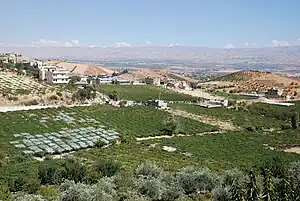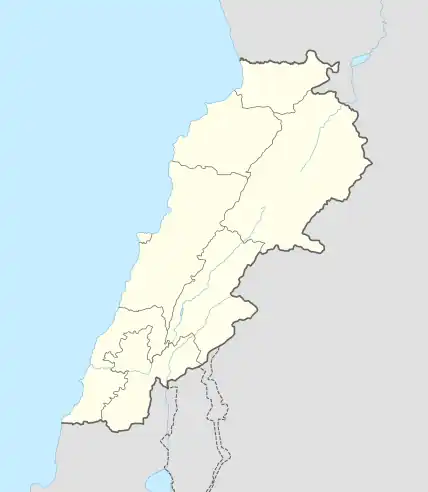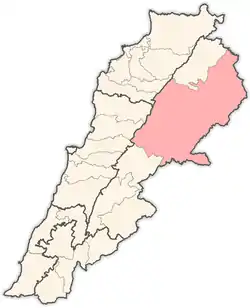Kasarnaba
قصرنبا | |
|---|---|
 Grapes in vineyard below village of Qsarnaba | |
 Kasarnaba Location in Lebanon | |
| Coordinates: 33°54′52″N 35°59′22″E / 33.91444°N 35.98944°E | |
| Country | |
| Governorate | Baalbek-Hermel |
| District | Baalbek |
| Elevation | 3,970 ft (1,210 m) |
| Time zone | UTC+2 (EET) |
| • Summer (DST) | +3 |
Kasarnaba (Arabic: قصرنبا) is a town in Baalbek District, Baalbek-Hermel Governorate, Lebanon famous for its hilly terrain and Traditional Agricultural practices.
Geography
The town is located at the shoulder of The Western Lebanese Mountain Range just to the East of Mount Sanine specifically and it overlooks the central parts of Beqaa Valley.
History
A Roman Temple is found in this town, called "Castra El Banaat".
In 1838, Eli Smith noted Kasarnaba's population to be predominantly Metawileh.[1]
People in Kasarnaba are traditionally farmers famous for growing vineyards and wild rose flowers for rosewater extraction, in addition to many other traditional Horticultural crops some of which are listed below.
In 1994 Mustafa Dirani was abducted by Israeli forces from his home in Kasarnaba. He was held (without charge) by Israel until 2004.[2][3]
Traditional Crops
- Grapes
- Cherries
- Apricots
- Common Fig
- Roses (for Rosewater)
- Tobacco
Landscape
Kasarnaba has many hills creating deep valleys in between including:
- Wadi El Hawr
- Wadi El Debs
- Wadi El Boss
- Wadi Neita
- Wadi ain el Louis
- wadi ain al chaghour
- wadi al zaraet
- wadi al toghra
- wadi malek
References
- ↑ Robinson and Smith, 1841, vol 3, 2nd appendix, p. 144
- ↑ Lebanese guerrilla abducted by Israel, Tom Hundley, May 22, 1994, Chicago Tribune
- ↑ "Mid-East Prisoners Welcomed Home". news.bbc.co.uk. 29 January 2004. Retrieved 13 April 2021.
Bibliography
External links
- Qsarnaba, Localiban
